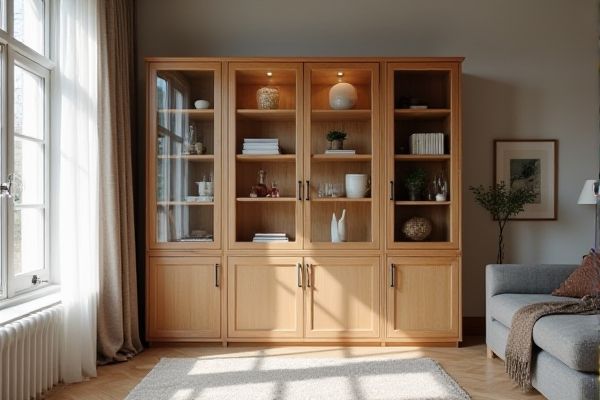
Glass-front cabinets showcase your dishware and add visual depth to your kitchen, making the space feel more open and inviting, while solid cabinets offer a sleek, uniform look and conceal clutter for a cleaner appearance. Explore the rest of the article to discover which cabinet style best suits your design preferences and functional needs.
Table of Comparison
| Feature | Glass-Front Cabinet | Solid Cabinet |
|---|---|---|
| Visibility | Transparent, displays contents | Opaque, hides contents |
| Design Style | Modern, elegant look | Traditional, classic appearance |
| Maintenance | Requires frequent cleaning | Low maintenance |
| Durability | Fragile, prone to cracks | Robust and sturdy |
| Storage Privacy | Low, items are visible | High, contents concealed |
| Cost | Generally higher | Generally lower |
| Lighting Effect | Enhances natural and artificial light | Blocks light |
Introduction to Glass-Front and Solid Cabinets
Glass-front cabinets showcase contents through transparent panels, adding a decorative element and allowing easy visibility of your items. Solid cabinets offer a more concealed storage option, providing a clean and uniform look while protecting contents from dust and light. Choosing between glass-front and solid cabinets depends on your preference for display versus privacy in storage solutions.
Aesthetic Appeal: Transparency vs Opacity
Glass-front cabinets offer a sleek, modern aesthetic by showcasing the contents inside, creating a sense of openness and lightness in your space. Solid cabinets provide a more traditional, sturdy appearance, emphasizing opacity that conceals items for a clean, minimalist look. Your choice between transparency and opacity significantly influences the overall visual impact and style of your interior design.
Storage Functionality and Accessibility
Glass-front cabinets enhance storage functionality by allowing easy visibility of contents, reducing the time spent searching for items and facilitating quick inventory checks. Solid cabinets offer better protection from dust and light, preserving the condition of stored goods while providing a more uniform and concealed storage solution. Accessibility in glass-front cabinets is improved through visual cues, whereas solid cabinets rely on organization and labeling for efficient retrieval.
Display Opportunities: Showcasing Items
Glass-front cabinets provide unparalleled display opportunities by allowing visibility of decorative items, collectibles, and fine dishware while protecting them from dust. Solid cabinets conceal contents entirely, offering a clean, minimalist look but limiting the ability to showcase prized possessions. Choosing glass-front cabinetry enhances aesthetic appeal and personalized decor through transparent, illuminated presentation options.
Durability and Maintenance Requirements
Glass-front cabinets feature tempered glass panels that offer moderate durability but require regular cleaning to prevent fingerprints and smudges, making maintenance somewhat higher than solid cabinets. Solid cabinets, typically made from hardwood or engineered wood with durable finishes, provide excellent longevity and resistance to scratches, demanding less frequent upkeep. Both types benefit from routine dusting and gentle cleaning products, but solid cabinets generally offer lower maintenance needs and better durability in high-traffic kitchen environments.
Organization and Clutter Management
Glass-front cabinets enhance organization by providing clear visibility of contents, making it easier to locate items quickly and maintain order. They encourage clutter control since visible items must be neatly arranged to preserve aesthetic appeal. Solid cabinets conceal items entirely, offering a cleaner look but requiring more rigorous internal organization to prevent disarray.
Cost Differences and Installation Considerations
Glass-front cabinets typically cost more than solid cabinets due to the price of tempered glass and additional manufacturing processes. Installation of glass-front cabinets requires extra care to avoid damage and often involves specialized hardware for secure mounting. Your choice may also impact labor costs, as glass-front cabinets usually demand more precise handling and alignment during installation.
Suitability for Different Room Styles
Glass-front cabinets complement modern and contemporary room styles by adding lightness and showcasing decorative dishware, enhancing visual interest. Solid cabinets suit traditional and rustic interiors, providing a warm, streamlined appearance and concealing storage for a clutter-free look. Choosing between glass-front and solid cabinets depends on the desired balance between display and privacy in the room's design.
Cleaning and Upkeep Comparisons
Glass-front cabinets require more frequent cleaning to maintain their clarity and prevent visible fingerprints and smudges, demanding a gentle glass cleaner and a soft cloth for upkeep. Solid cabinets tend to hide dust and fingerprints better but need regular dusting and occasional polishing to maintain their finish and prevent wear. Your choice between the two should consider the time you can dedicate to cleaning, as glass-front cabinets generally need more attention to stay visually appealing.
Choosing the Right Cabinet for Your Needs
Glass-front cabinets offer a stylish display option, making them ideal for showcasing dishware and decorative items while adding depth and light to a room. Solid cabinets provide greater privacy and protection from dust, suited for storing everyday kitchen essentials and bulky items out of sight. Selecting between glass-front and solid cabinets depends on whether visibility or concealment aligns better with your storage needs and design preferences.
 homyna.com
homyna.com